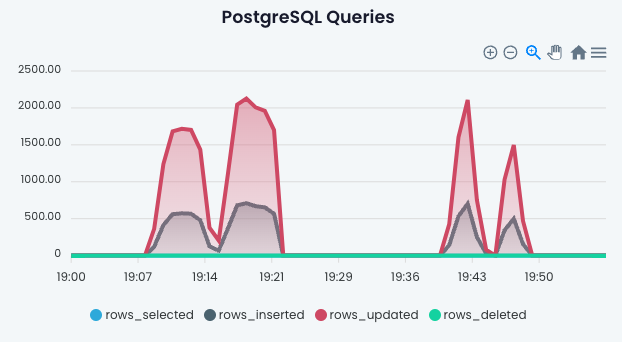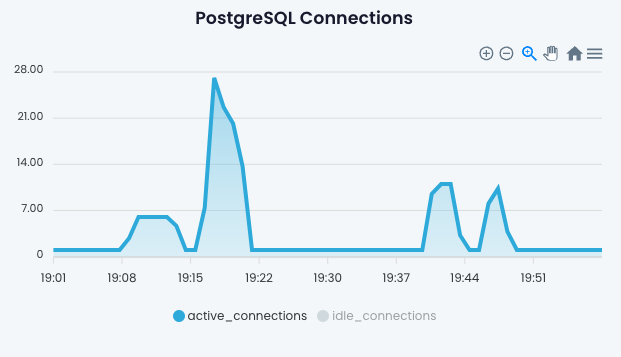
PostgreSQL Monitoring: Optimizing Performance on Linux and Windows Servers
PostgreSQL, also known as Postgres, is a free and open-source relational database management system emphasizing extensibility and SQL compliance. To PostgreSQL running at peak performance and ensure your applications hum along smoothly, you need robust monitoring and resource management. Xitoring is providing you with the best solution on both Linux and Windows environments.


PostgreSQL Server Performance Metrics
Monitoring PostgreSQL involves tracking crucial performance metrics. Here are the essential ones to consider:
- CPU Usage: Monitoring CPU usage is vital to ensure efficient processing and prevent performance bottlenecks.
- Memory Usage: PostgreSQL utilizes system memory extensively. Monitoring memory consumption helps optimize resource allocation.
- Active Connections: Keep track of active connections to manage server load and prevent connection limitations.
- Idle Connections: Monitoring idle connections aids in resource management and optimizing server performance.
- Cache Hit: Measure cache hit rates to gauge the effectiveness of query caching and optimize database performance.
- Total Disk Space: Monitoring total disk space usage ensures sufficient storage capacity for database operations.
- Database Deadlocks: Detect and resolve database deadlocks promptly to prevent transaction conflicts and ensure data integrity.
- Active Queries: Monitor active queries to identify performance bottlenecks and optimize query execution.
- Waiting Queries: Identify and address waiting queries to minimize query response times and improve overall performance.
- Committed Transactions: Track committed transactions to ensure data consistency and integrity.
- Rollback Transactions: Monitor rollback transactions to identify transaction failures and potential performance issues.
- Read Disk Blocks: Measure read disk block operations to optimize database read performance and minimize disk I/O bottlenecks.
- Rows Returned: Keep track of the number of rows returned by queries to optimize query performance and resource utilization.
- Rows Selected: Monitor the number of rows selected to optimize query efficiency and minimize resource usage.
- Rows Inserted: Track the number of rows inserted to ensure efficient data insertion and database performance.
- Rows Updated: Monitor the number of rows updated to optimize update operations and database efficiency.
- Rows Deleted: Keep track of the number of rows deleted to optimize delete operations and maintain database performance.
PostgreSQL Monitoring: The Xitoring Advantage
All-in-One Monitoring Solution for Linux and Windows Servers
When it comes to PostgreSQL monitoring, Xitoring shines as an all-encompassing solution, meticulously designed for Linux and Windows servers alike.
- Real-time Monitoring: Stay informed about PostgreSQL performance metrics with real-time monitoring and immediate alerts.
- Enhanced Security: Safeguard your PostgreSQL server with comprehensive security features.
- Windows Compatibility: Xitoring seamlessly integrates with Windows servers, providing unmatched versatility.
- User-Friendly Interface: Experience effortless monitoring and management through our intuitive dashboard.
Xitoring – Your PostgreSQL server’s ultimate ally!

How to start monitoring your PostgreSQL?
- 1
Install Xitogent
Easily run one command and install Xitogent on your Linux or Windows server
- 2
Enable Integration
Now run `xitogent integrate` on your server and select PostgreSQL, It will ask for a few params and credentials to proceed
- 3
Configure Triggers
You can easily configure several triggers and alerts and receive them in your favorite notification channel.
Get started with Xitoring PostgreSQL Monitoring today
FAQ
What is PostgreSQL, and why is monitoring important for it?
PostgreSQL, also known as Postgres, is a free and open-source relational database management system emphasizing extensibility and SQL compliance. To PostgreSQL running at peak performance and ensure your applications hum along smoothly, you need robust monitoring and resource management
What are the key metrics to monitor in PostgreSQL?
Important metrics include memory usage, CPU usage, Queries, Connections, and cache hit rate.
How does Xitoring simplify PostgreSQL monitoring?
Xitoring offers real-time monitoring, security features, Windows compatibility, and an intuitive interface, making it an all-in-one solution for PostgreSQL monitoring on both platforms.
How long does it take to setup PostgreSQL monitoring?
If you have Xitogent running on your server on average it would take three minutes to configure and make everything running!
More technical details can be found here: How to monitor PostgreSQL on Xitoring
What kind of alerts do I get for PostgreSQL monitoring?
There are many options to configure your customized trigger and alerts, including
- CPU
- Memory
- Active connections
- Idle connections
- Cache hit
- Total disk space
- Database deadlocks
- Active queries
- Waiting queries
- Committed transactions
- Rollback transactions
- Read disk blocks
- Rows returned
- Rows selected
- Rows inserted
- Rows updated
- Rows deleted
Need Help or Quote?
Have questions or need assistance? Our dedicated support team is here to help. Reach out to us anytime, and we’ll be happy to assist you.

